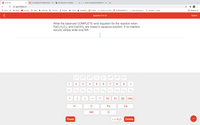
Chemistry
10th Edition
ISBN: 9781305957404
Author: Steven S. Zumdahl, Susan A. Zumdahl, Donald J. DeCoste
Publisher: Cengage Learning
expand_more
expand_more
format_list_bulleted
Question

Transcribed Image Text:**Question:**
Write the balanced COMPLETE ionic equation for the reaction when Fe(C₂H₃O₂)₃ and Ca(OH)₂ are mixed in aqueous solution. If no reaction occurs, simply write only NR.
**Instructions for Entering the Ionic Equation:**
Use the provided symbols and numbers to construct the balanced ionic equation. The available options include:
- Numbers: 0-9
- Charges: 4-, 3-, 2-, 1-, 1+, 2+, 3+, 4+
- Mathematical symbols: +, →
- States of matter: (s), (l), (g), (aq)
- Elements and compounds: H, C, Fe, Ca, O
- Special compounds and terms: xH₂O, NR
- Control buttons: Reset, Delete
**Note:** Ensure you enter the states of matter and charges correctly for each ion and compound. If no reaction takes place, use the NR option to indicate this.
This exercise is designed to help students practice writing balanced ionic equations by selecting the appropriate options from a virtual keypad.
Expert Solution
This question has been solved!
Explore an expertly crafted, step-by-step solution for a thorough understanding of key concepts.
Step by stepSolved in 2 steps with 1 images

Knowledge Booster
Learn more about
Need a deep-dive on the concept behind this application? Look no further. Learn more about this topic, chemistry and related others by exploring similar questions and additional content below.Similar questions
- #18, explainarrow_forwardWrite the balanced Net Ionic equation for the reaction when magnesium iodide and sodium carbonate are mixed in aqueous solution. If no reaction occurs simply put NR.arrow_forwardDoes a reaction occur when aqueous solutions of silver(I) sulfate and calcium nitrate are combined?arrow_forward
- Question 28 of 34 Submit An aqueous solution of Mg(NO,), and NaOH generates the solid precipitate Mg(OH),. Which of the following would NOT appear in the corresponding net ionic reaction? A) Mg2 B) NO, 3 С) ОН D) Mg(OH), 2 E) Both (A) and (C) +arrow_forwardThe net ionic equation for the reaction of cobalt(II) chloride and potassium phosphate in an aqueous solution isarrow_forwardDoes a reaction occur when aqueous solutions of barium bromide and nickel(II) sulfate are combined?arrow_forward
- Write the balanced NET ionic equation for the reaction when cesium hydroxide and sulfurix acid are mixed in aqueous solution. If no reaction occurs, simply write only NR.arrow_forwardWrite the balanced molecular chemical equation for the reaction in aqueous solution for copper(I) bromide and potassium sulfate. If no reaction occurs, simply write only NR.arrow_forwardFill in and explain please 6arrow_forward
- Write the balanced net ionic equation for the reaction. Include phases. (The video shows the addition of aqueous sodium carbonate to a solution of aqueous magnesium nitrate.)arrow_forwardDoes a reaction occur when aqueous solutions of magnesium acetate and calcium bromide are combined?arrow_forwardExplain why no precipitation formed when solutions of iron (lll) chloride and sodium sulfate were combined?arrow_forward
arrow_back_ios
SEE MORE QUESTIONS
arrow_forward_ios
Recommended textbooks for you
 ChemistryChemistryISBN:9781305957404Author:Steven S. Zumdahl, Susan A. Zumdahl, Donald J. DeCostePublisher:Cengage Learning
ChemistryChemistryISBN:9781305957404Author:Steven S. Zumdahl, Susan A. Zumdahl, Donald J. DeCostePublisher:Cengage Learning ChemistryChemistryISBN:9781259911156Author:Raymond Chang Dr., Jason Overby ProfessorPublisher:McGraw-Hill Education
ChemistryChemistryISBN:9781259911156Author:Raymond Chang Dr., Jason Overby ProfessorPublisher:McGraw-Hill Education Principles of Instrumental AnalysisChemistryISBN:9781305577213Author:Douglas A. Skoog, F. James Holler, Stanley R. CrouchPublisher:Cengage Learning
Principles of Instrumental AnalysisChemistryISBN:9781305577213Author:Douglas A. Skoog, F. James Holler, Stanley R. CrouchPublisher:Cengage Learning Organic ChemistryChemistryISBN:9780078021558Author:Janice Gorzynski Smith Dr.Publisher:McGraw-Hill Education
Organic ChemistryChemistryISBN:9780078021558Author:Janice Gorzynski Smith Dr.Publisher:McGraw-Hill Education Chemistry: Principles and ReactionsChemistryISBN:9781305079373Author:William L. Masterton, Cecile N. HurleyPublisher:Cengage Learning
Chemistry: Principles and ReactionsChemistryISBN:9781305079373Author:William L. Masterton, Cecile N. HurleyPublisher:Cengage Learning Elementary Principles of Chemical Processes, Bind...ChemistryISBN:9781118431221Author:Richard M. Felder, Ronald W. Rousseau, Lisa G. BullardPublisher:WILEY
Elementary Principles of Chemical Processes, Bind...ChemistryISBN:9781118431221Author:Richard M. Felder, Ronald W. Rousseau, Lisa G. BullardPublisher:WILEY

Chemistry
Chemistry
ISBN:9781305957404
Author:Steven S. Zumdahl, Susan A. Zumdahl, Donald J. DeCoste
Publisher:Cengage Learning

Chemistry
Chemistry
ISBN:9781259911156
Author:Raymond Chang Dr., Jason Overby Professor
Publisher:McGraw-Hill Education

Principles of Instrumental Analysis
Chemistry
ISBN:9781305577213
Author:Douglas A. Skoog, F. James Holler, Stanley R. Crouch
Publisher:Cengage Learning

Organic Chemistry
Chemistry
ISBN:9780078021558
Author:Janice Gorzynski Smith Dr.
Publisher:McGraw-Hill Education

Chemistry: Principles and Reactions
Chemistry
ISBN:9781305079373
Author:William L. Masterton, Cecile N. Hurley
Publisher:Cengage Learning

Elementary Principles of Chemical Processes, Bind...
Chemistry
ISBN:9781118431221
Author:Richard M. Felder, Ronald W. Rousseau, Lisa G. Bullard
Publisher:WILEY